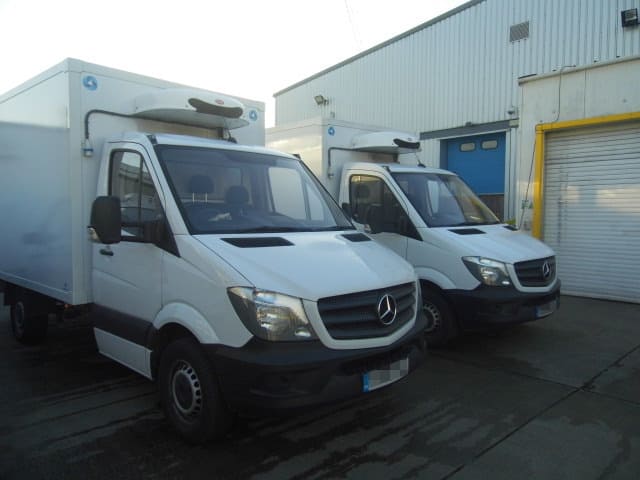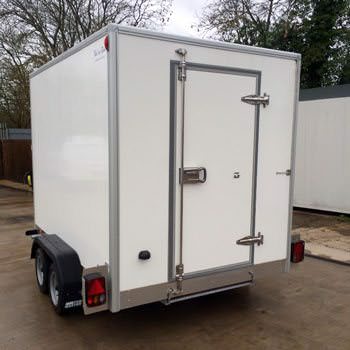The weeks that the Met Office calls “summer” are the critical stress-test for any chilled or frozen delivery fleet. July and August combine long daylight hours, high ambient temperatures and congested roads, all of which conspire to push fridge plants, electrics and insulation to their limits.
A van or trailer that sails through a January route can falter as soon as the thermometer nudges 25 °C. A structured summer maintenance plan is therefore neither a luxury nor a tick-box exercise; it is the most cost-effective insurance you can buy against product loss, lost contracts, and reputational damage.
Why Summer Maintenance Matters More Than Winter Servicing
Cold air is forgiving; hot air is not. In winter, your condenser can reject heat with ease because the outside air is already cool. Come summer, the same component has to vent heat into air that may be three or four times warmer.
The compressor runs longer, draws more current and reaches its high-pressure safety limit faster. Meanwhile, every door opening lets a surge of warm, moist air into the load space. That moisture freezes onto the evaporator plate, blocking airflow and forcing extra defrost cycles.
Even the van itself suffers: batteries operate less efficiently at high temperatures, and alternators spend more of their output feeding cooling fans instead of recharging.
Without pre-emptive maintenance, these stresses combine to create the perfect storm — voltage dips, iced-up coils, false set-point readings and, ultimately, spoiled cargo. A single rejected pallet of fresh seafood or a pharmaceutical return can wipe out the cost of a full-fleet summer service in seconds.
Build a Summer-Ready Inspection Routine
Think of summer maintenance as three overlapping layers: pre-season checks, in-season driver routines and rapid-response support.
Pre-Season Checks (Ideally April or Early May)
- Full leak and pressure test. A technician attaches high- and low-side gauges and compares readings with the manufacturer’s 20 °C chart. Any deviation hints at a leak or a blocked condenser.
- Deep clean of heat exchangers. Brush, vacuum and, if necessary, low-pressure water-wash the condenser from inside out. Straighten bent fins with a fin comb and apply a light coil-protective coating.
- Battery and alternator health. Perform a load test on the battery, aiming for at least 70 % of its original cold-crank amps. Confirm the alternator maintains 14 V or more with fans running.
- Door seals and hinges. Close the rear doors on a torch; if you see light through the rubbers, warm air will follow. Replace compressed or torn seals and adjust hinges so they draw the door tightly.
- Insulation scan. A handheld thermal camera or even an infrared thermometer quickly reveals wet patches inside panels. Damp insulation loses half its thermal resistance and should be dealt with before peak season.
- Controller calibration and firmware updates. Verify the load probe against a reference thermometer at 5 °C and +5 °C. Update firmware — many new versions include smarter high-ambient logic.
- Defrost-cycle adjustment. Shorten automatic defrost intervals by five to ten minutes during hotter months to pre-empt ice build-up.
Document every step: service sheets, calibration certificates and photos of replaced parts form a powerful audit trail if an inspector knocks in August.
In-Season Driver Routines
A fifteen-minute refresher keeps faults small:
- Pre-cool each morning. Run the unit to its set-point at least thirty minutes before loading. Otherwise, the walls themselves act as heaters.
- Fast, organised loading. Stage pallets or cages in drop order, park as close as possible to the cold store and use insulated covers for anything that must wait.
- Door discipline. Fit strip curtains and, where possible, an audible alarm that sounds after sixty seconds of door open time.
- Daily walk-around. Feel for a strong draft of warm air from the condenser grille, listen for unusual rattles and cross-check dashboard temperature with an independent probe.
- Fuel and battery awareness. Many diesel fridge engines shut down below 15 % fuel; fill up at a quarter of a tank, and watch battery voltage after long idle periods.
Rapid-Response Support
Even the best maintenance cannot prevent every breakdown, so have a plan for the one in ten faults that occur despite your efforts:
- Carry an emergency kit: spare high-amp fuses, a digital thermometer, a head torch, a jump-pack and a roll of clear polythene for temporary doorway curtains.
- Know your hotline. Make sure drivers have the FridgeXpress 24/7 number and a laminated fault-code guide in the cab. Many alarms can be reset remotely once the cause is confirmed.
- Set up telematics alerts. A message the instant the load space drifts 2 °C above set-point buys you precious minutes to intervene before stock warms through.
How FridgeXpress Makes Summer Simple
There’s not much that the team at FridgeXpress doesn’t know about refrigerated vans and trailers. We understand that the key to a successful operation is a properly maintained fleet. Seasonal changes bring different challenges, and staying on top of them is critical.
- Flexible hire terms. You can scale capacity up for six weeks of festival or seaside demand, then return the extra units with no long-term burden.
- Regular maintenance: Our lease options include maintenance and servicing, ensuring that your vehicle remains on the road rather than in the garage.
- Pro-active alerts. High-quality telematics and digital services mean that you can easily stay on top of maintenance requirements at all times.
Action Plan for the Coming Summer
Developing an action plan can save a lot of time and heartache for fleet managers. Your plan could include, for example:
- Book your pre-season service now — slots fill quickly once the first warm spell is forecast.
- Audit your emergency kits and replace missing items; batteries and fuses have a habit of wandering.
- Run a fifteen-minute driver briefing covering pre-cooling, loading order and door discipline.
- Set up telematics alarms a full degree tighter than winter thresholds; hot air works faster than cold.
- Discuss contingency hires with FridgeXpress so we can reserve matching vehicles in June and July. A quick call today prevents a panicked scramble later.
Summer maintenance is not a nice-to-have; it is the shield that protects every kilogram of chilled or frozen product you carry during the hottest, busiest weeks of the year.
By investing a few hours per vehicle before the heat arrives, training drivers to spot early warning signs and partnering with FridgeXpress for both expertise and back-up capacity, you turn an unpredictable British summer into just another profitable season.
If you’d like to find out more about how FridgeXpress can help your business, contact our expert team today.




